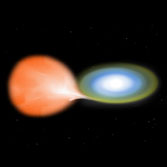|
|
White Dwarfs & Planetary Nebulas

Chandra image of Sirius A & B in X-rays. The bright source is Sirius B, a white dwarf star |
Observations of white dwarfs are difficult because they cool quickly and become dim. When they are very young and hot their surfaces can produce X-rays. On these rare occasions X-ray telescopes provide valuable information about the nature of a newly formed white dwarf.
Fortunately, there are other possible conditions that allow astronomers to observe X-rays from a white dwarf. These opportunities occur when a white dwarf is capturing matter from a nearby companion star. As captured matter falls onto the surface of the white dwarf, it accelerates and gains energy. This energy goes into heating gas on or just above the surface of the white dwarf to temperatures of several million degrees. The hot gas glows brightly in X-rays.

Illustration of Accreting White Dwarf
Credit: (Illustration) NASA/CXC/M.Weiss |
A careful analysis of this process can reveal the mass of the white dwarf, its rate of rotation and the rate at which matter is falling onto it. In some cases, the matter that accumulates on the surface can become so hot and dense that nuclear reactions occur. When that happens, the white dwarf suddenly becomes 10,000 times brighter as the explosive outer layers are blown away in what is called a nova outburst. After a month or so, the excitement is over and the cycle begins anew.
To think of a white dwarf as a "burned out" or "dead" star can be misleading. It is more like a transformation or metamorphosis from one stage to the next. As X-ray observations prove, under the right conditions an old star can be quite lively indeed.
|